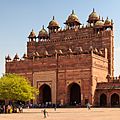Fatehpur Sikri facts for kids
'Fatehpur Sikri' or the city of victory is a town in the Agra District of Uttar Pradesh, India. The city was founded in 1569 by the Mughal Emperor Akbar, and served as the capital of the Mughal Empire from 1571 to 1585, when it was abandoned. After his military victories over Chittor and Ranthambore, Akbar decided to shift his capital from Agra to a new location 23 miles (37 km) west south-west, to honour the Sufi saint Salim Chishti. Here, he commenced the construction of a planned walled city, which took the next fifteen years in planning and construction, with a series of royal palaces, harem, courts, a mosque, private quarters and other utility buildings. He named the city Fatehabad, with Fateh, a word of Arabic origin in Persian, meaning "victorious." It was later called Fatehpur Sikri. It is at Fatehpur Sikri that the legends of Akbar and his famed courtiers, the nine jewels or Navaratnas, were born. Fatehpur Sikri is one of the best preserved examples of Mughal architecture in India.
Contents
Architecture
- Buland Darwaza
- Jama Masjid
- Tomb of Salim Chishti
- Diwan-i-Aam
- Diwan-i-Khas
- Ibadat Khana
- Mariam-uz-Zamani's Palace
- Anup Talao
- Naubat Khana
- Hiran Minar
- Birbal's House
- Panch Mahal
Demographics
Fatehpur Sikri has a population of 28,757. Males constitute 53% of the population and females 47%. Fatehpur Sikri has an average literacy rate of 46%, lower than the national average of 74%; male literacy is 57%, and female literacy is 34%. In Fatehpur Sikri, 59% of the population is under 6 years of age.
Images for kids
-
Kos Minar#793 at 12-mile on Agra-Fatehpur Sikri Road section of National Highway 21
See also
 In Spanish: Fatehpur Sikri para niños
In Spanish: Fatehpur Sikri para niños




















